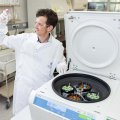More than 100,000 Australians suffering high blood pressure can now be cured or have their problem greatly improved by surgical treatment thanks to University of Queensland research.
A team of researchers led by Professor Richard Gordon and Associate Professor Michael Stowasser has found primary aldosteronism (PAL) – a type of high blood pressure that can be cured by surgery – to be ten times more common than was previously suspected. Once thought to be rare, the Endocrine Hypertension Research Centre found PAL in 10% of all hypertension sufferers, making it the commonest known curable cause.
“Surgery is the only chance these people have of a cure. Their quality of life improves dramatically without the side affects caused by blood pressure medications.
“Patients on blood pressure medication require indefinite monitoring by their doctor to keep a check on their health. It would be a shame for people to miss the opportunity to be cured,” he said.
Excess hormonal activity by the adrenal glands causes this type of hypertension. When only one of the two adrenal glands is overactive, it can be safely removed, curing the condition.
Professor Stowasser said people with hypertension should ask their doctor about whether they could benefit from the procedure. While he was sharing his knowledge with the medical profession here and overseas, the complexity of the diagnostic process meant it was not yet widely available.
“The procedure relies on a complex diagnostic process to identify excess hormonal activity followed by hormonal sampling of the adrenal glands by a radiologist experienced in this type of work. Our research in Brisbane has lead to the development of a leading unit for this type of diagnosis and treatment in Australia and internationally. Expertise has been developed at Brisbane’s Greenslopes Private Hospital and the Princess Alexandra Hospital where we are diagnosing 70 -100 PAL sufferers each year,” he said.
Over 300 adrenalectomies have been carried out, with excellent results, Prof Stowasser said.
Professors Gordon and Stowasser’s earlier research discovered PAL was responsible for more cases of hypertension than previously thought. PAL affects the lives of possibly more than 300,000 Australian aged between 20 and 80, about 10% of all hypertension sufferers. The surgical treatment is available to around one third of people with PAL. When only one of the two adrenal glands is overactive, it can be safely removed, curing or greatly improving the condition.
These researchers have also turned their attention to the genetic basis of the condition, which can run in families and have found a part of one chromosome which is involved. This line of research should lead to streamlined diagnosis and even identification of children who would be at risk of developing hypertension in later life.
Patient enquiries: Contact your GP to discuss having a blood test that will provide initial information on whether you are a candidate for this treatment. Please note: Further testing at a specialist unit in a capital city may be required.
Media inquiries: Faculty Communications Officer Marlene McKendry (07 33464713 or 0401 996847).
Download high resolution photos here: http://omc.uq.edu.au/images/Hypertension/



